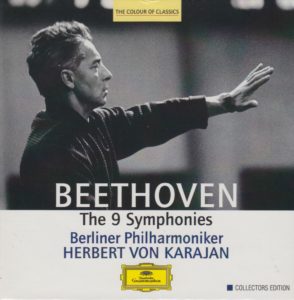
My listening spot of choice this morning is, once again, our balcony.
Truth be told, it’s my favorite place to listen to music and write. But it means I’ll have to drive farther to get to my office when I’m done; whereas, if I was at Panera I’d be a mile and a half from my office.
Oh, well.
 This morning’s conductor is Austrian Herbert von Karajan (1908-1989) – “Generally regarded as one of the greatest conductors of the 20th century,” according to his bio on Wikipedia – conducting the Berliner Philharmoniker. It is one of the symphonies (specifically, Beethoven’s Symphony No. 3 in E flat Major) in Karajan’s ’63 cycle.
This morning’s conductor is Austrian Herbert von Karajan (1908-1989) – “Generally regarded as one of the greatest conductors of the 20th century,” according to his bio on Wikipedia – conducting the Berliner Philharmoniker. It is one of the symphonies (specifically, Beethoven’s Symphony No. 3 in E flat Major) in Karajan’s ’63 cycle.
This is the third time I’ve heard Maestro Karajan from tapes taken from his legendary 1963 cycle. The first time was Day 10. The second was Day 28. Both times, I tried to avoid the Cult of Karajan, a.k.a. Karajan Worship Syndrome.
And yet, I awarded both previous encounters with Conductor Karajan the coveted “Huzzah!” rating.
Coincidence?
Hopefully. I’d hate to think I’ve succumbed to the Cult of K.
Let’s see how things stack up this morning.
First, from the superb liner notes written by Richard Osborne,
The scope, the symphonic reach of the Eroica is immense. The first movement is itself an epic journey, something which is partly a matter of length, principally a matter of tonal farsightedness. Here, range is matched with an uncanny structural poise.
All of these points are here to ponder in this gloriously played and gloriously projected performance under Karajan. Recorded, along with the Ninth Symphony, at the very end of the famous 1962 Berlin sessions, this Eroica is one of the pinnacles of a justly celebrated cycle.
Indeed.
 Beethoven wrote his symphonies in four parts (except for the Sixth, which is in five). The time breakdown of this particular one (Symphony No. 3 in E flat Major), from this particular conductor (Karajan, at age 54) and this particular orchestra (Berliner Philharmoniker), at this particular time in history (December 1961 and January 1962) on this particular record label (Deutsche Grammophon) is as follows:
Beethoven wrote his symphonies in four parts (except for the Sixth, which is in five). The time breakdown of this particular one (Symphony No. 3 in E flat Major), from this particular conductor (Karajan, at age 54) and this particular orchestra (Berliner Philharmoniker), at this particular time in history (December 1961 and January 1962) on this particular record label (Deutsche Grammophon) is as follows:
I. Allegro con brio………………………………………………………………………14:49
II. Marcia funebre: Adagio assai……………………………………………….17:10
III. Scherzo: Allegro vivace – Trio…………………………………………………6:48
IV. Finale: Allegro molto – Poco andante – Presto…………………..12:20
Total running time: 50:27
My Rating:
Recording quality: 4 (the DG label doesn’t release crap; except for some noticeable tape hiss, and this is first-rate despite its 50+-years age)
Overall musicianship: 5
CD liner notes: 5 (Nice, thick 54-page booklet with lengthy essays by Richard Osborne about each symphony, translated into English, German, and French, and all pertinent technical info)
How does this make me feel: 5
Maybe I’ve been drinking the Karajan Kool-Aid. But I’m going to have to give this performance, like the previous two, a rousing “Huzzah!” rating.
This held me spellbound from the first two chords of the first movement to the last notes of the fourth movement – which, by the way, is an epic journey all by itself.
I was even willing to go along for the 17+-minute Adagio that is Movement II. It was so well done that I couldn’t help myself. I was powerless to do anything but let this marvelous music wash over me.
The recording is masterful. Each instrument rings out. This is a lavish recording of a noteworthy performance.
Highly recommended!
